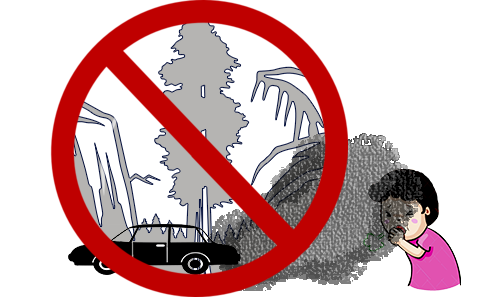By Tanli Su

Here’s an easy way for you to reduce your everyday greenhouse gas emissions: stop idling your car engine. In case you didn’t know, idling is the act of leaving a vehicle engine running while it is not moving, especially while it is parked (this excludes stopping at a traffic light and cases where someone might need the engine running for special reasons). Idling happens everyday at various places—some examples of idling occur when parents wait to pick up their kids from school or when people wait in line at drive-through restaurants. The most common case, however, is when people idle by just sitting in their car for a long time before they leave, perhaps to “warm up” their car, search for directions, play with their phones, or sip some coffee while the engine runs unnecessarily. Unfortunately, idling is extremely common and has many harmful effects.
First, idling wastes gas and money and damages your engine. Letting a vehicle idle for more than 10 seconds actually uses more fuel than turning it off and restarting; as a result, you could save two to five tanks of gas each year by simply changing your habits. Idling also wears down your engine faster because the engine is not at peak temperature while idling, and so fuel is only partially combusted. Some people say that they idle in order to warm up their car, but the best way to warm up your engine and cabin interior is actually by driving, not idling.
Reducing idling will also make the air healthier by decreasing the amount of hazardous pollutants around us. Breathing in air toxins from vehicle exhaust fumes has been linked to serious illnesses such as asthma, heart disease, chronic bronchitis, and cancer. Since children’s lungs are still developing, they are especially vulnerable to developing health issues like asthma, which is the most common chronic disease among children. Furthermore, idling often occurs when parents pick up their kids from school, which increases the amount of hazardous pollutants that children are exposed to.
Besides harming people’s health, idling also harms the environment. The pollutants released by vehicle tailpipes produce smog, soot, and acid rain, and also contribute to climate change. An idling vehicle emits 20 times more pollution than a vehicle traveling at 30 miles per hour, and idling your engine for just ten minutes releases a pound of carbon dioxide into the air.
Each day in the U.S., idling cars emit a total of 40,000 tons of carbon monoxide and waste $13 million and 3.8 million gallons of fuel. Many states already have incentives or laws in place to reduce idling, and many local anti-idling ordinances and programs also exist. However, laws prohibiting idling are inevitably hard to enforce, and many people are unaware that idling is even a problem. Please help spread the word about this important issue—reducing idling is a simple and effective lifestyle eco-action that will simultaneously improve our health, environment, and quality of life!
If you are interested in joining the anti-idling campaign, please contact:
Tanli Su, Climate Action Leadership Youth Team Chair, Loma Prieta Chapter, Sierra Club
tanli.su@yahoo.com
Image by Andy Zeng